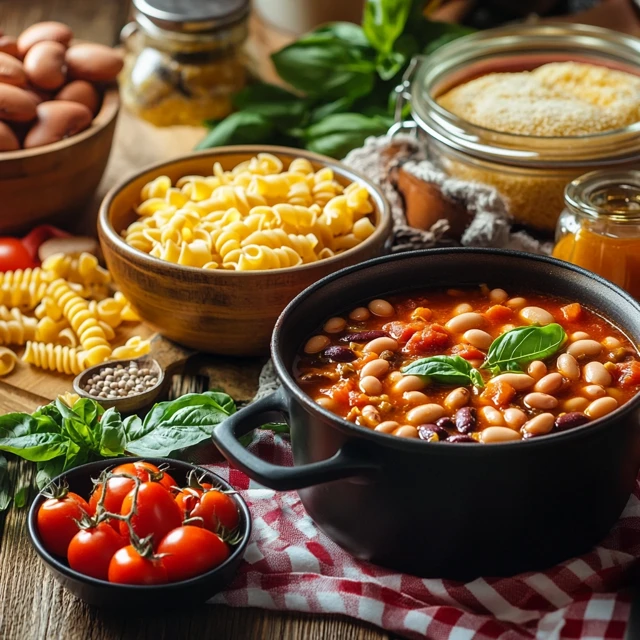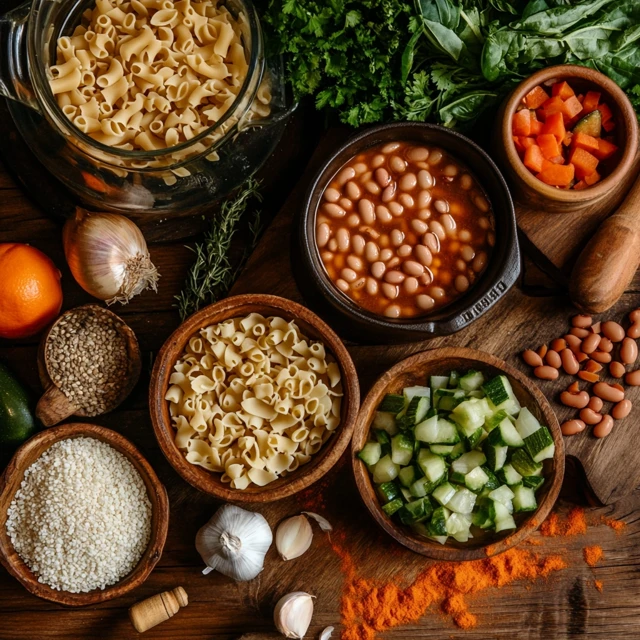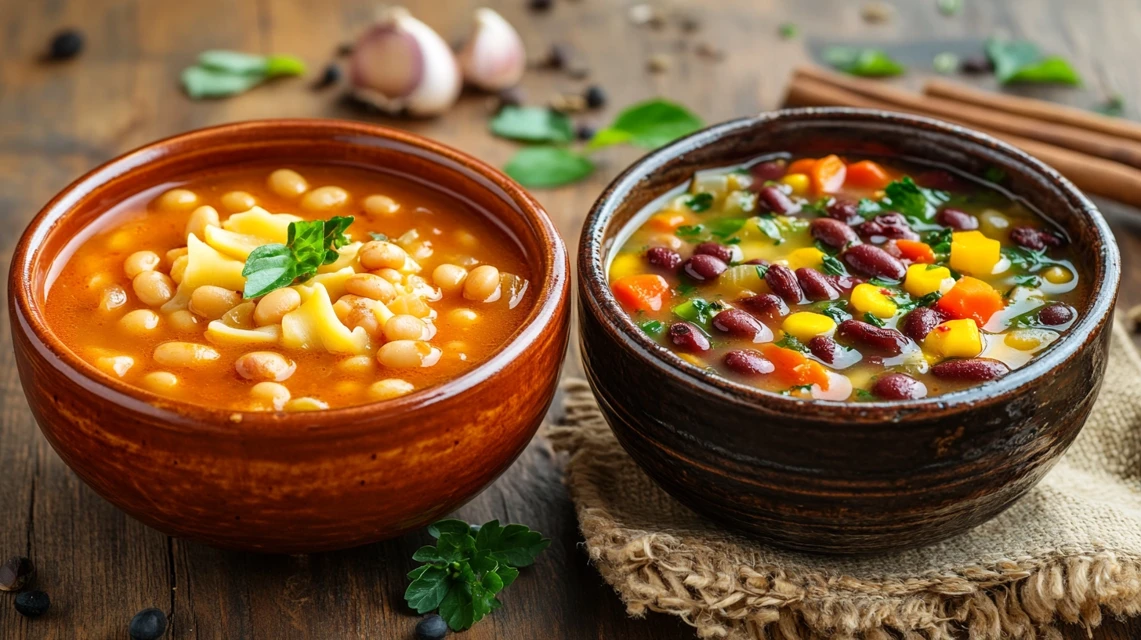Pasta Fagioli and Minestrone are two beloved Italian soups that have been enjoyed for generations. While they may seem similar at first glance, these dishes have distinct differences in ingredients, texture, and cultural significance. Understanding their unique characteristics can help you choose the perfect soup for your next meal.
Introduction to Pasta Fagioli and Minestrone
Both Pasta Fagioli and Minestrone originate from Italy and are known for their comforting flavors and nutritious ingredients. They share common elements such as beans and pasta but differ in their overall composition and preparation.
Origins and History of Both Dishes
Pasta Fagioli:
This dish, which translates to “pasta and beans,” has humble origins in Italian peasant cuisine. It was created as an affordable and filling meal, using pantry staples like pasta, beans, and simple seasonings. Over time, it became a beloved comfort food across Italy and beyond, with variations depending on the region.
Minestrone:
Minestrone, on the other hand, has a broader history and is considered one of Italy’s oldest soups. The name comes from the Italian word minestra, which means “soup.” It was originally a way to use leftover vegetables, making it highly adaptable to seasonal ingredients. Unlike Pasta Fagioli, Minestrone has evolved into a more vegetable-centric dish.
Cultural Significance in Italian Cuisine
Both soups hold a special place in Italian culture, often served during family gatherings and as part of traditional meals.
- Pasta Fagioli: Seen as a hearty, protein-rich dish that provides sustenance, especially in colder months. It is commonly enjoyed as a main course due to its filling nature.
- Minestrone: Considered a more versatile and lighter option, Minestrone is often served as a starter or a side dish before the main meal. It represents the Italian philosophy of using fresh, seasonal produce.
Despite their differences, both soups showcase the resourcefulness of Italian cuisine—turning simple ingredients into flavorful, satisfying dishes.
check out this https://eassyrecipes.com/category/dinner/
Key Ingredient Differences
While both soups contain pasta and beans, their ingredient lists and overall compositions differ significantly.
Pasta Fagioli Ingredients Overview
Pasta Fagioli is a simple dish that primarily revolves around two key ingredients—pasta and beans. The soup often features:
- Beans: Typically cannellini or borlotti beans, known for their creamy texture.
- Pasta: Small pasta shapes such as ditalini, elbow macaroni, or small shells.
- Tomatoes: Some variations include crushed tomatoes, while others stick to a clear broth.
- Garlic and Onion: Used to build a rich base flavor.
- Herbs: Commonly includes basil, oregano, and rosemary.
- Olive Oil: Adds richness and enhances flavor.
- Broth: Can be vegetable or meat-based, depending on preference.
Minestrone Ingredients Overview
Minestrone, known for its variety of vegetables, has a more complex ingredient profile, which typically includes:
- Vegetables: Carrots, celery, zucchini, potatoes, and green beans are commonly used.
- Beans: Kidney beans or white beans add protein and texture.
- Pasta or Rice: While pasta is common, some versions use rice instead.
- Tomatoes: Often included to provide acidity and richness.
- Herbs: Thyme, basil, and parsley are frequently used.
- Broth: Usually vegetable-based, but sometimes beef or chicken broth is used for added depth.
The flexibility of Minestrone allows for a wide range of ingredient substitutions based on seasonal availability and personal preferences.
check out this https://eassyrecipes.com/category/dinner/
Comparing the Main Components
While both dishes share some similarities, they differ in the following key aspects:
| Component | Pasta Fagioli | Minestrone |
|---|---|---|
| Main Focus | Pasta and beans | Vegetables |
| Consistency | Thick and hearty | Brothy with a mix of textures |
| Flavor Profile | Rich and savory | Light and fresh |
| Serving Style | Typically served as a main course | Often served as a starter or side |
Understanding these differences can help you decide which dish best suits your taste and dietary preferences.
Texture and Consistency Variations

Pasta Fagioli and Minestrone may share some ingredients, but their textures and consistencies set them apart. Understanding these differences can help you choose the right soup depending on your preference for thickness or a lighter broth.
Pasta Fagioli: Thick vs. Soupy
Pasta Fagioli is known for its thick, almost stew-like consistency. The dish’s thickness primarily comes from the combination of beans and pasta, which absorb much of the broth during cooking. Some versions of Pasta Fagioli are even thicker, resembling a hearty pasta dish rather than a soup.
Factors that contribute to its thickness include:
- Mashing Beans: Some recipes call for partially mashing the beans to release starches, thickening the broth naturally.
- Pasta Absorption: Small pasta shapes like ditalini soak up the broth, making the dish denser over time.
- Minimal Liquid: Traditional Pasta Fagioli often has just enough broth to coat the ingredients without being overly watery.
However, some regions of Italy prefer a soupy version, using more broth and serving it with crusty bread to soak up the liquid.
check out this https://eassyrecipes.com/category/dinner/
Minestrone: A Brothy Vegetable Soup
In contrast, Minestrone is typically lighter and brothy, with a higher ratio of liquid to solids. It is designed to highlight the fresh flavors of seasonal vegetables, with the broth serving as a key component of the dish.
Key elements that create Minestrone’s broth-based consistency include:
- Vegetable Broth: Minestrone is often made with a light vegetable or chicken broth, providing a more fluid texture.
- Fresh Vegetables: The dish includes water-rich vegetables like zucchini, tomatoes, and green beans that contribute to a thinner consistency.
- Rice or Pasta as a Secondary Ingredient: Unlike Pasta Fagioli, where pasta is a star component, in Minestrone, pasta or rice is added sparingly to complement the vegetables.
Minestrone’s brothiness makes it a great starter before a main course or a light meal on its own.
Which Is More Filling?
When it comes to satiety, Pasta Fagioli tends to be the more filling option due to its hearty ingredients and thicker texture. The combination of beans and pasta provides a balanced source of protein and carbohydrates, making it a satisfying meal.
On the other hand, Minestrone, with its high vegetable content and lighter broth, can be a better choice for those looking for a low-calorie, nutrient-dense meal that doesn’t leave you feeling too full.
Choosing between the two depends on factors such as:
- Appetite: If you’re looking for a hearty, stick-to-your-ribs meal, Pasta Fagioli is the way to go.
- Nutritional Goals: Those looking for a lower-calorie option may prefer Minestrone.
- Occasion: Pasta Fagioli works well as a standalone dish, while Minestrone pairs nicely with other dishes as a starter.
Cooking Techniques and Preparation

Although both soups are relatively easy to prepare, their cooking methods differ slightly due to the ingredients involved.
How Pasta Fagioli Is Traditionally Made
Pasta Fagioli typically follows a straightforward process:
- Sautéing Aromatics: Onion, garlic, and sometimes celery and carrots are sautéed in olive oil to build a flavorful base.
- Adding Beans and Tomatoes: Cannellini or borlotti beans are added, along with diced tomatoes and broth.
- Simmering: The soup simmers until the beans are tender, allowing the flavors to meld.
- Cooking Pasta Separately: To avoid mushy pasta, it is often cooked separately and added just before serving.
- Seasoning and Serving: Fresh herbs and a drizzle of olive oil enhance the final dish.
Cooking time for Pasta Fagioli is usually around 30–45 minutes, depending on whether dried or canned beans are used.
Step-by-Step Process for Minestrone
Minestrone follows a similar structure but involves a wider variety of vegetables:
- Chopping Fresh Vegetables: Carrots, zucchini, potatoes, and celery are prepared for cooking.
- Sautéing the Base: Onion and garlic are sautéed in olive oil before adding the chopped vegetables.
- Adding Broth and Tomatoes: Vegetable or chicken broth is poured in, along with tomatoes and beans.
- Simmering the Soup: The mixture is cooked slowly to allow the vegetables to soften and the flavors to develop.
- Adding Pasta or Rice: This is typically added in the final minutes to prevent overcooking.
Minestrone usually takes around 40–60 minutes to cook, as it requires more time for the vegetables to soften and the flavors to blend.
Cooking Time and Complexity Comparison
| Aspect | Pasta Fagioli | Minestrone |
|---|---|---|
| Preparation Time | 10-15 minutes | 15-20 minutes |
| Cooking Time | 30-45 minutes | 40-60 minutes |
| Skill Level | Beginner | Beginner to Intermediate |
| Complexity | Simple, with fewer ingredients | More complex due to varied vegetables |
Both soups require minimal cooking skills, making them great options for home cooks of all experience levels.
FAQs About Pasta Fagioli vs. Minestrone
Pasta Fagioli and Minestrone are two popular Italian soups, each with its own unique qualities. Many people have questions about how they compare, especially when it comes to ingredients, preparation, and their popularity in Italy. Below, we answer some of the most frequently asked questions about these two beloved dishes.
Is Pasta e Fagioli the Same as Minestrone?
No, Pasta e Fagioli (commonly called Pasta Fagioli) is not the same as Minestrone. Although both dishes are Italian soups that contain pasta and beans, they have significant differences in ingredients, texture, and flavor.
Key Differences:
| Feature | Pasta Fagioli | Minestrone |
|---|---|---|
| Main Focus | Pasta and beans | Vegetables |
| Base | Tomato-based or broth-based | Broth-based (vegetable, chicken, or beef) |
| Consistency | Thick and hearty | Light and brothy |
| Vegetable Content | Minimal vegetables, mostly beans and pasta | Loaded with various fresh vegetables |
While Pasta Fagioli centers around the rich combination of pasta and beans, Minestrone is more vegetable-forward with a lighter broth.
What Is the Difference Between Minestrone and Pasta Fagioli at Olive Garden?
At Olive Garden, both Minestrone and Pasta Fagioli are popular soup options, but they have notable differences in flavor and ingredients.
Olive Garden Minestrone:
- A vegetarian-friendly soup packed with vegetables such as carrots, zucchini, tomatoes, green beans, and spinach.
- Uses a light tomato-based broth flavored with Italian herbs and spices.
- Includes pasta and beans but focuses on the variety of vegetables.
Olive Garden Pasta Fagioli:
- Heavier and more filling with a focus on small pasta, red and white beans, and ground beef.
- Has a thick, tomato-based broth that makes it more stew-like.
- Seasoned with garlic, onion, and Italian herbs for a rich, comforting taste.
While Minestrone is lighter and vegetarian-friendly, Pasta Fagioli at Olive Garden offers a heartier option with a meat-based addition.
What Does Minestrone Mean in Italian?
The word Minestrone comes from the Italian verb minestrare, meaning “to serve” or “to administer.” The term evolved to describe a thick, hearty vegetable soup that serves as a nourishing meal.
First, Italian cooks created Minestrone as a clever way to use up leftover vegetables and grains, which shows how they turned simple ingredients into something special. In fact, the name itself tells us about the soup’s important role in Italian cooking—as it helps families make the most of basic, seasonal ingredients to create filling meals.
Moreover, as Italians have enjoyed Minestrone for hundreds of years, each region has developed its own special version of the soup, with local cooks proudly featuring the vegetables and flavors that grow best in their area.
Do Italians Eat Minestrone?
Yes, Italians frequently enjoy Minestrone, especially during colder months when a warm, hearty soup is comforting. Minestrone is a staple in many Italian households, thanks to its adaptability and nutritional benefits.
Common occasions when Italians eat Minestrone include:
- As a first course: Often served before the main dish in traditional Italian meals.
- Seasonal meals: Minestrone is made with seasonal vegetables, making it a popular year-round choice.
- Health-conscious diets: Italians appreciate the soup’s healthy balance of vegetables, fiber, and light broth.
In northern Italy, Minestrone is often thicker, featuring potatoes and legumes, while in southern Italy, it tends to be lighter with a focus on fresh tomatoes and herbs. Regardless of the variation, Minestrone remains a beloved dish that reflects Italy’s emphasis on fresh, wholesome ingredients.
Conclusion
First of all, though both Pasta Fagioli and Minestrone rank as well-loved Italian soups, they each bring something different to the table. For example, Pasta Fagioli mainly combines pasta and beans to create a filling meal full of protein. On the other hand, Minestrone offers a lighter, brothy mix, packed with fresh vegetables that change with the seasons.
So, when you’re hungry, you can pick between these two tasty choices. If you want something thick and filling, go for Pasta Fagioli. But if you’re in the mood for something lighter with lots of vegetables, then Minestrone will hit the spot. Either way, both soups showcase the wonderful ways Italians cook their food.
Therefore, the next time you eat out or cook at home, you’ll know just which soup to pick based on what you like to eat and what makes your body feel good.

